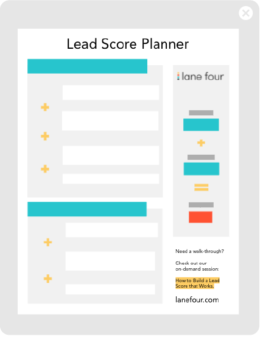It’s no secret that sales and marketing alignment is needed for companies to scale. Research shows that companies with aligned revenue teams achieve 20% annual revenue growth.
We also know that aligning the two departments is easier said than done. While marketing is under pressure to bring in high volumes of “good” leads, sales works overtime to convert them into dollars.
Inevitably, the two departments clash, causing the entire revenue engine to sputter.
Tear Down the Walls Between Sales and Marketing
While there are many factors that go into sales and marketing alignment, a solid first step is to create a lead score that both teams can agree on.
A lead score acts as a guideline for everyone. Marketing will be able to develop strategies to attract leads that fit the ICP. Meanwhile, sales can spend more time on prospects that are more likely to buy.
It all sounds simple on paper, but it brings us to the age old question: what actually makes a “good” lead?
5-Stars or 112-Flowers?
As consumers, we all know that 5-star ratings are the best. Some time during the course of history, the majority of society decided that a 5-star rating system should be the standard. When you check into a 5-star hotel, you know to expect something top-notch.
But what if one day you travel to a distant land where local consumers have been thriving under their own unique flower rating system? As you check into your 122-flower rated hotel, some questions start popping into your head:
How many flowers equal a star?
How many flowers make up the flower rating system?
A lead with a score of 60 or 100 or 5 can pose the same problem. This is why just having a lead score isn’t enough. If sales and marketing don’t have a shared understanding of what the score means, and do a good job of building it, you may be generating more questions than answers.

Building a Lead Score That Works: A 3-Step Process
To avoid confusion, your lead score should be built collaboratively with the entire revenue team. Whether it’s sales, marketing, ops, or even the product team, a good lead score mustn’t be built in silos.
Our SaaS Practice manager Aidas Dirse explains it best: “At the end of the day, everyone wants to help drive revenue. Everyone has a revenue role in a scaling SaaS.”
Below is a 3-step approach to building a revenue driving lead score.
1. Define What Is “Good”
When you ask sales and marketing to define a “good” lead, you’re likely to get vastly different answers.
That’s why the first step to building a lead score is to collaborate on a set of parameters that define “good” for your company.
Broadly speaking, a good lead maintains a balance of 1) ICP profile fit and 2) high interest in your product.
Depending on your company goals, you may value one over the other. Spend some time to come to a consensus on how to weigh the importance of these 2 factors.
This is a crucial step because it helps marketing narrow in on their targets. As a result, when leads are filtered and passed on to the sales team, the reps know they are already in good position to close.
It’s important to note that “good” is not a fixed definition. Things are always changing, whether it’s customer needs, your own business objectives, or unpredictable world events. Your score should be reviewed on a regular basis and adjusted to reflect the changes that affect your business.
2. Turn Your Lead Score into a Priority Score
Once your team defines what is good, it’s time to translate it into a score. But we like to think beyond the traditional lead score, and we encourage you to do the same. Here’s why:
The term “lead score” runs into some contextual issues. Think about this: every inbound lead is given a lead score. But without additional context (account information, for example), a sales rep won’t know the quality of that lead and whether it should be prioritized.
However, when you turn a lead score into a priority score, everyone immediately knows the value of those leads. Without doing any more research, a rep will know that a lead assigned with a priority score is one that’s always worth their time.
To build a priority score, you’ll need to gather some information to establish a person score and an account score.
Person Score
We suggest using 4 core components to generate a person score:
1. Person ICP Score: This is self-explanatory. Gather information about your target audience such as title, department, and seniority.
2. Campaign Score: This is your traditional marketing score. Score a lead based on their activity levels with your multi-channel campaigns (ex. webinars, website visits, downloads).
3. Campaign Member Status Score: This is the level of engagement with a specific campaign (ex. webinar registration vs. attendance).
4. Intent: This includes 1st and 3rd party intent. You can gather 3rd party intent information from paid tools like Bombora or Zoominfo.
Account Score
We suggest using 3 core components to generate an account score:
1. Account ICP Score: This can include target industries, company revenue, number of employees, and other key ICP information.
2. Account Activity Score: Total campaign activity on an account (ex. how many people from one account are engaging with your content).
3. Intent: This is similar to person intent, and includes a company’s total 1st and 3rd party intent.
Keep in mind that a priority score doesn’t necessarily need all of the above information. A great way to start is by using our Lead Score Planner to gather bits of information to gradually build upon your score as you scale.
3. Take Action with Matching & Routing
Your priority score is only as valuable as the actions it informs. This means getting your leads to the right people quickly, and making sure they follow up.
With so many routing decisions to be made for each lead (Are there dupes in Salesforce? Are they already a customer? Is someone already working the account?), this process can be complicated and time-consuming. Assigning leads using native Salesforce functions can be clunky. If you’re running sophisticated go-to-market strategies like ABM, it can be impossible.
This quote from Aidas sums it up nicely: “Salesforce is a beautiful puzzle – it’s just missing a couple of key pieces.”
Dynamic lead-to-account matching and routing tools provide these missing pieces to make the process of scoring and assigning leads more flexible – and automated. With a matching and routing tool in place, you can bring key data from accounts into leads, which will not only help build a more accurate score in the first place, but also help get those leads to the right people fast.
Another benefit to these tools is auto-merge, which de-dupes your leads and merges them with existing records as they come in. This alleviates any worry about inadvertently having multiple reps working the same account, or having the wrong person reach out to an existing prospect. In real time, a tool like Lane Four Highroad will automatically identify a duplicate and route it to the appropriate rep based on your custom rules.
The only thing your reps have to worry about is working the priority leads coming their way.
A Good Score Is a Flexible One
Building a priority score that addresses the goals of both sales and marketing is the first step to proper alignment. But it doesn’t end there.
Circling back to the point made earlier, your teams need to be in constant communication to revise and adjust the score. At the very least, the score should be reviewed every year to reflect changes around your business.
Building a priority score may seem daunting at first. Use our Lead Score Planner to follow along with our SaaS Practice managers as they explain what you need to get started in your quest for sales and marketing alignment.
